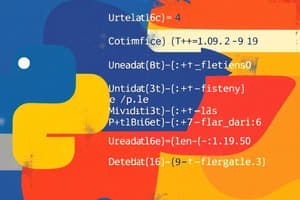Podcast
Questions and Answers
Insertion sort is always inefficient for large datasets.
Insertion sort is always inefficient for large datasets.
False
Bubble sort is stable and adapts well to nearly sorted arrays.
Bubble sort is stable and adapts well to nearly sorted arrays.
True
The time complexity of selection sort is O(n) for all cases.
The time complexity of selection sort is O(n) for all cases.
False
The merge algorithm has a time complexity of O(nLog n) which is faster than bubble sort.
The merge algorithm has a time complexity of O(nLog n) which is faster than bubble sort.
Signup and view all the answers
Linear search requires the data to be sorted to function correctly.
Linear search requires the data to be sorted to function correctly.
Signup and view all the answers
In Python, a tuple's index cannot be changed, just like a list's index.
In Python, a tuple's index cannot be changed, just like a list's index.
Signup and view all the answers
Insertion sort has a best-case time complexity of O(n).
Insertion sort has a best-case time complexity of O(n).
Signup and view all the answers
All sorting algorithms are guaranteed to have a space complexity of O(1).
All sorting algorithms are guaranteed to have a space complexity of O(1).
Signup and view all the answers
What is the worst-case time complexity for insertion sort?
What is the worst-case time complexity for insertion sort?
Signup and view all the answers
Which sorting algorithm is best suited for small or nearly sorted arrays?
Which sorting algorithm is best suited for small or nearly sorted arrays?
Signup and view all the answers
Which of the following searches requires the data to be sorted?
Which of the following searches requires the data to be sorted?
Signup and view all the answers
What is the space complexity of bubble sort?
What is the space complexity of bubble sort?
Signup and view all the answers
Which sorting algorithm is not stable?
Which sorting algorithm is not stable?
Signup and view all the answers
What should you do if a variable is giving an error due to a case sensitivity issue in Python?
What should you do if a variable is giving an error due to a case sensitivity issue in Python?
Signup and view all the answers
What is the total time complexity for bubble sort in the worst-case scenario?
What is the total time complexity for bubble sort in the worst-case scenario?
Signup and view all the answers
What is the time complexity of merge sort?
What is the time complexity of merge sort?
Signup and view all the answers
Study Notes
Python Variable Errors
- Check variable names for case sensitivity.
- Ensure variable names are not Python keywords.
- Variable names should not contain spaces, commas, or symbols.
- Variable names cannot begin with a digit.
Lab 4: List Operations
- Inserting at the back: Constant time complexity (O(1)).
- Inserting at the front: Linear time complexity (O(n)).
- Time complexities (from best to worst): O(1), O(log n), O(n), O(n log n), O(n2), O(2n), O(n!).
Lab 6: Sorting Algorithms
-
Bubble Sort: Compares adjacent elements and swaps if necessary.
- Best case: O(n).
- Worst case: O(n2).
-
Selection Sort: Finds the minimum element and swaps it.
- All cases: O(n2).
-
Insertion Sort: Inserts elements into their correct position in a sorted sub-list.
- Best case: O(n).
- Worst case: O(n2).
- All sorting algorithms have a space complexity of O(1).
-
Best Choices:
- Insertion Sort: Good for small or nearly sorted arrays.
- Bubble Sort: Not ideal for large datasets.
- Selection Sort: Avoid due to always being O(n2).
- Merge Sort: Fastest sorting algorithm; O(n log n) time complexity.
-
Stability:
- Insertion and Bubble sorts are stable.
- Selection sort is not stable.
-
Adaptability:
- Insertion Sort: Adaptable for nearly sorted data.
- Bubble Sort: Slightly adaptable for nearly sorted data.
- Selection Sort: Not adaptable. Used to minimize writes.
Lab 7: Indexing
- Array indexes start at 0.
- Array index end must be minus one.
Lab 8: Linear Search
- Linear search (sequential search) checks each element until the target is found.
- Does not require a sorted list.
Lab 9: Binary Search
- Binary search requires a sorted list.
- It repeatedly divides the search interval in half.
-
Time Complexities:
- Linear search: O(n).
- Binary search: O(log2 n).
Lab 10: Tuple Immutability
- Tuples are immutable; you cannot change their elements.
- Attempting to change a tuple element will result in an error.
Lab 11: Variable Identity
- Assigning a variable to another:
c = acreates a reference (same identity). - Slicing a list or using a new index:
d = a[:]creates a new object (different identity).
Lab 12: List Sorting Methods
-
sort(): Modifies the original list in-place (same identity). -
sorted(): Creates a new sorted list (different identity).
Studying That Suits You
Use AI to generate personalized quizzes and flashcards to suit your learning preferences.
Description
Test your knowledge on Python variable naming rules and list operations. This quiz covers variable case sensitivity, time complexities of list insertion, and sorting algorithms. Challenge yourself to see how well you understand these fundamental concepts in Python.




